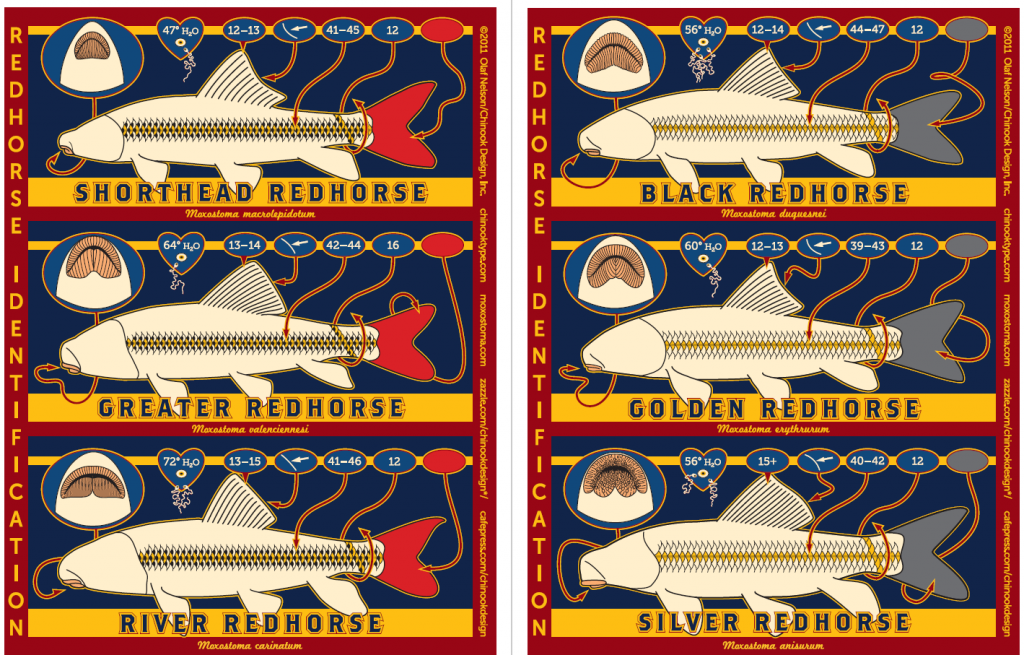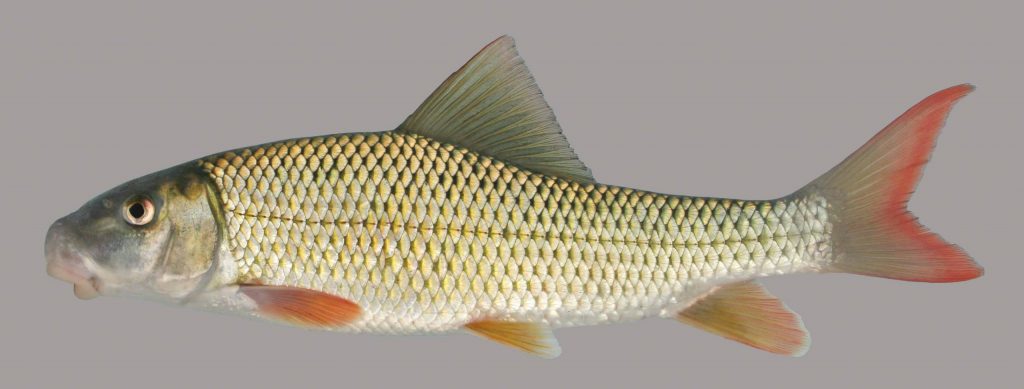Get to know these members of the sucker family – Identification and Distribution

Redhorse belong to the sucker family (Catistomidae, genus Moxostoma) and there are 12 species in North America, but only 6 are relatively common. These fish have large, shiny scales and maintain a solid body coloration with some of the species sporting vibrant orange/red fin and tail coloration. Like typical suckers, their mouth’s are located on the underside of the head and the shape of the fish’s fleshy lips can help in identifying which species you come in contact with.
Redhorse prefer clean streams and rivers and are rarely found in polluted, silty or overly fertile waters. The presence of redhorse is an indication of health in a lake or river and unfortunately many redhorse populations have been impacted by unhealthy water conditions. Some states have even taken steps to help protect certain species by placing them on the endangered, threatened, or “special concern” lists.

Greater Redhorse are the largest of the common species, attaining weights up to 17 pounds. They are primarily found in rivers and streams throughout the upper Midwest from eastern South Dakota to northern New York. They are well adapted to feed on clams, snails and similar food items thanks to crushing molar-like teeth, but they will feed on worms and aquatic invertebrates as well. They have a large mouth and a rounded head and snout and in many states they are considered threatened.

River Redhorse are often confused with Greater Redhorse as they both grow to large sizes. However, they can be distinguished by a sharper tip on the top of the caudal (tail) fin, as well as the lip structure and the number of scales around the tail. River Redhorse prefer large, clean rivers with relatively swift waters, but they can also be found in lakes. They feed on most of the same foods as the Greater Redhorse, but they have a much larger distribution including states throughout the Midwest south to Mississippi and Alabama.

Shorthead Redhorse are a common species that have bright orange/red tail and fin coloration. The have small mouths and primarily feed on aquatic invertebrates. They are more tolerant of turbid waters and have a distribution throughout the upper Midwest into Canada and even into some of the eastern states like Virginia. The Shorthead Redhorse can exceed 10 lbs. and reach 29 inches in length.

Silver Redhorse are another redhorse species that reaches impressive sizes with fish reaching up 14 lbs. They also frequent clean, clear lakes, rivers and streams with gravel riffles and resting pools. They have a fairly wide distribution with populations in central Canada and across the upper Midwest from Minnesota to upstate New York. This fish has a fin and tail coloration that ranges from light orange to grey and lips with bumps instead of ridges that helps to distinguish this fish from other redhorse species.

The Golden Redhorse has a vibrant golden hue in it’s scales with slate grey fin and tail coloration. These fish can reach 30 inches in length and exceed 10 lbs. The are found throughout the central and eastern US. They frequent the same clean water ecosystems as the other species. The lip configuration and coloration are key distinguishing characteristics.

The Black Redhorse is found in pockets throughout the upper Midwest and down into Oklahoma and Arkansas. These fish seek out small, clean streams with woody debris and gravel bottoms. Their fins and tail are slate to dark grey and they have 10 rays in the pelvic fin, while similar species only have 9.
Additional species like the Grayfin, Blacktail, Notchlip, Sicklefin, Smallmouth, V-Lip and Robust Redhorse have smaller, unique distributions throughout areas of the Ohio River valley and across some of the southern and southeastern states in the US.
Redhorse are easily caught on hook and line using bait like worms, as well as by bowfishing in the clear waters they inhabit. They spawn in the spring to early summer and school up making them easy to find and target. As a native species it is best to exercise constraint when encountering these species and it’s important to understand your state’s stance on redhorse populations to ensure that no threatened or endangered species are accidentally harvested.




Add comment